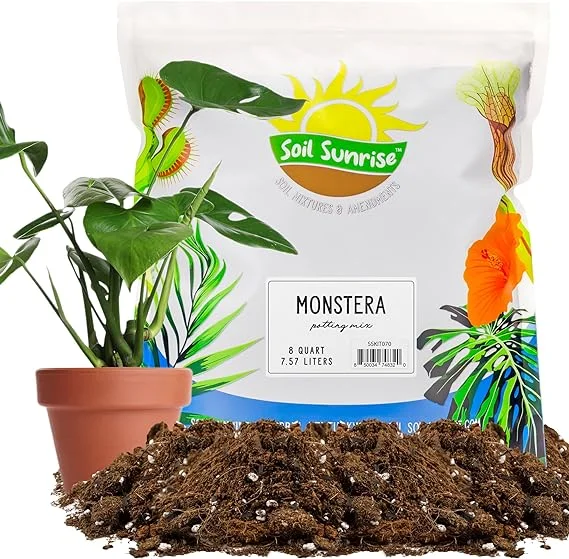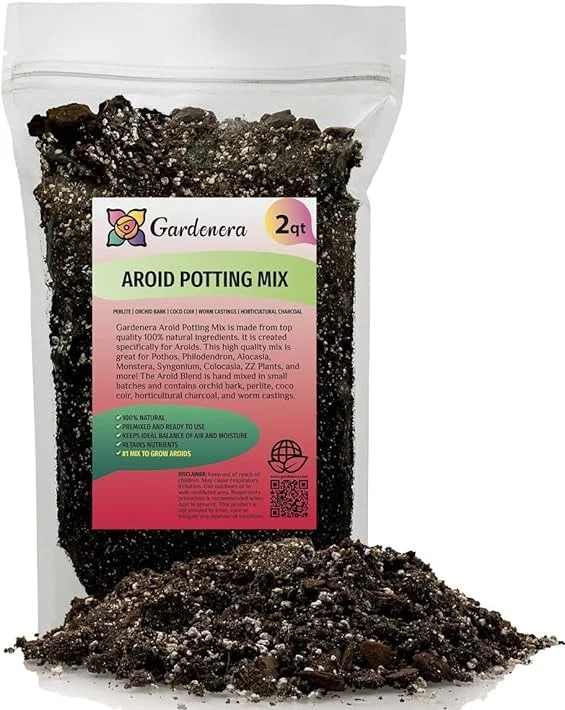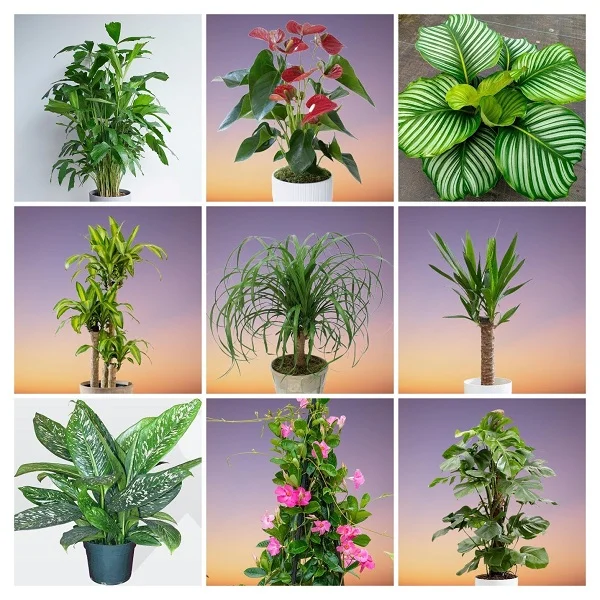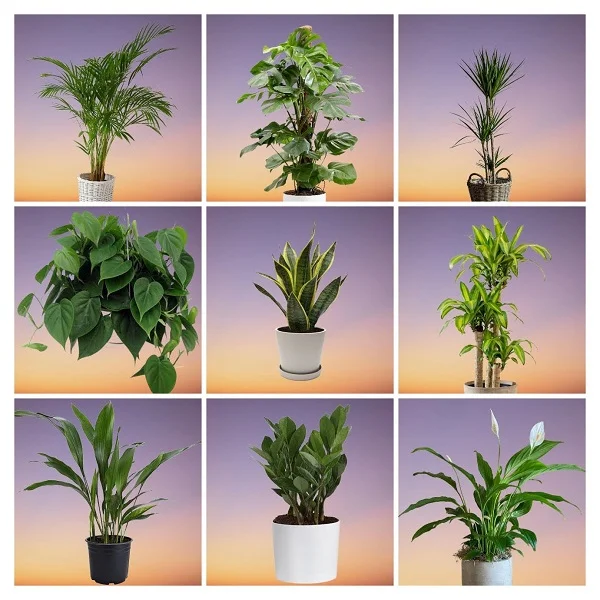Monstera deliciosa (Swiss Cheese Plant) Indoor Care, Propagation, Common Problems
Some links in this post may be affiliate links
Swiss Cheese Plant (Monstera deliciosa) thrives in medium to bright indirect light, warm and humid conditions and moderately moist, rich, well-drained soil coupled with monthly feeding in the growing period.
Monstera deliciosa is one of the popular Monstera varieties with large, deeply perforated leaves which are a sight to behold in any space.
The leaves in a young plant are smaller and entire with no lobes or holes but soon produce lobed and fenestrate leaves as they grow.
Swiss Cheese Plant is among the bold statement plants for occupying large empty spaces. To produce an upright plant, provide a moss stick to support it and also push the aerial roots into the soil.
The name 'deliciosa' means 'delicious' referring to the edible fruit. 'Monstera' means 'monstrous' referring to the size that this plant can grow to, over 30 feet (9 metres) in the wild.
The common name 'Swiss Cheese Plant' refers to the holes which develop in the leaves similar to those found in some Swiss cheeses. Other common names are fruit salad plant and fruit salad tree in reference to its edible fruit which tastes like fruit salad. Monster fruit, Mexican bread fruit, windowleaf among other names.

Botanical name: Monstera deliciosa
Family: Araceae
Common names: Swiss Cheese Plant, Split Leaf Philodendron, Monster Fruit, Mexican Breadfruit, Windowleaf Plant
Origin
Monstera deliciosa is native to tropical forests of Southern Mexico, South of Panama where it grows as an epiphyte on trees. It is one of the popular tropical foliage plants that you can grow in the home, office or any other space.
Size
Swiss Cheese Plant is among the fast-growing plants and can grow to a height of 20 feet or more when given a moss pole and the right growing conditions.
Toxicity
All parts except the fruit of Swiss Cheese Plant (Monstera deliciosa) are mildly toxic to humans and toxic to pets as outlined by ASPCA. If ingested, they will cause pain and swelling in the mouth, tongue and lips, vomiting, excessive drooling and difficulty in swallowing.
Invasiveness
Swiss Cheese Plant has been introduced to many tropical areas and has become mildly invasive species in Hawaii, Seychelles, Ascension Island and Society Islands.
Varieties
Various varieties of Monstera deliciosa are available. The form Albo-Variegata has white and cream lines or patches on the leaves.
Aurea-Variegata bears yellow or lime variegations on dark-green, perforated leaves.
Thai Constellation bears cream-colored splatters on the green leaves which resemble a starry night sky and this gives it the name 'Constellation'.
Where to Buy
Monstera deliciosa are a pleasant addition to your collection. You may obtain these plants online from Amazon (Link to Amazon) or from Etsy (Link to Etsy).
Monstera deliciosa Care Indoors
Swiss Cheese Plant (Monstera deliciosa) flourishes in medium to bright indirect light, average warmth of 18-290C, humidity of 50-55% and moderately moist, fertile, well-drained, Monsteras potting soil coupled with monthly feeding during the growing season.
Monstera deliciosa requires regular pruning to keep it neat, to discourage pest and disease infestations and to encourage a bushy growth. Repotting is done annually as it is a fast growing plant which requires adequate room for growth. Keep reading for a detailed account on these growing conditions and how to achieve them.
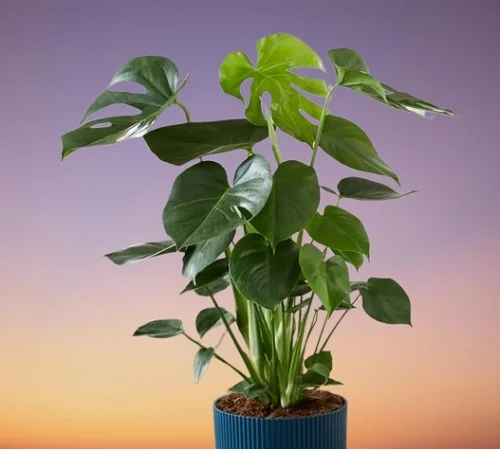
Watering
Water Monstera deliciosa liberally during the growing season and allow the top 2-3 inches of soil to dry out between waterings to keep the soil moderately moist.
Decrease watering during the cold season to keep the soil slightly moist but do not allow the soil to dry out completely.
Ensure that the pot has a drainage hole to prevent the soil from getting soggy as it can lead to root-rot and death of the plant.
Light Requirements
Monstera deliciosa grows best in medium to bright indirect light (filtered light). Keep its away from direct sunlight to prevent scorching of the leaves. Position it next to a sunless window or near a large brightly-lit window where it will receive enough light.
Swiss Cheese Plant produces small leaves and spindly leaf-stalks if the light is too low and it stops growing in deep shade. Where the natural lighting is not adequate, you may instal grow lights to supplement it. Check out these full spectrum grow lights on Amazon.
Every so often, rotate the pot to ensure that the plant receives adequate light from all sides for uniform growth and prevent leggy growth.
Temperature and Humidity
The best temperature for Swiss Cheese Plant is an average warmth of 18-290C. Keep it away from drafts to avoid sudden changes in temperatures which can cause leaf drop and reduced growth.
Average room humidity of 50-55% is ideal for Monstera deliciosa. Where the air is too dry, set the pot on a wet pebble tray to raise humidity. Read more on how to raise humidity for indoor plants.
Clean the leaves regularly by damp-wiping with a soft cloth to get rid of dust and discourage pest and disease infestations. Ensure that there is good air circulation to prevent fungal diseases.
Fertilizer
Feed Monstera deliciosa with a balanced, water-soluble fertilizer every 4 weeks during the growing period. Stop feeding in the cold season as growth is minimal and feeding at this time may lead to fertilizer burn.
Potting Soil
The best soil for Monstera deliciosa should be rich in organic matter and well-drained to prevent it from getting soggy while providing the required nutrients. Potting mixes designed for Monsteras and those designed for aroids are ideal for this plant.
Repotting
Repot Monstera deliciosa every 1-2 years during the growing season as the roots require adequate room to grow. Use a pot 2-3 sizes larger and one that has a drainage hole. Make sure that the pot has a drainage hole to prevent the soil from getting soggy as it can lead to root-rot. Check out these ceramic pots with saucers on Amazon.
Pruning
Pruning Monstera deliciosa is easy. Remove yellow and dead leaves to maintain the plant tidy as well as discourage pests and diseases. If the plant becomes too large and unruly, cutback the stems to the desired level to rejuvenate growth. The stems can be used to propagate new plants. Read more on how to prune houseplants.
Propagation
Monstera deliciosa propagation can be done at the beginning of the growing period by use of stem cuttings or by air layering. The stem cuttings can be rooted in soil or in water.
How to propagate Monstera deliciosa from stem cuttings in soil
Take a stem cutting from a healthy Swiss Cheese Plant by cutting at a point just below an aerial root. Just one leaf node with the leaf is enough to propagate a new plant.
Insert the cutting in moist well-drained soil. Ensure the rooting container has proper drainage to avoid getting soggy soil.
Place the set up in a well-lit, warm place and maintain the soil moist until new growth emerges.
Allow the new Swiss Cheese Plant to be well established before transplanting after which routine care can begin.
How to propagate Monstera deliciosa from stem cuttings in water
Take a stem cutting from a healthy Swiss Cheese Plant by cutting at a point just below an aerial root. Just one leaf node with the leaf is enough to propagate a new plant.
Dip the lower cut end in a rooting hormone to hasten rooting. Place the cutting in a jar containing plain water while ensuring that at least one leaf node is under water.
Position the set up in a well-lit spot and change the water every 5-7 days.
Once adequate roots have developed, plant the cutting in soil and place in a well-lit, warm place to enhance rooting.
Allow the new Monstera deliciosa to be well established before transplanting after which you can begin routine care.
How to propagate Monstera deliciosa by air layering
There are two methods of air layering Monstera deliciosa.
One method consists of notching the stem of a healthy Swiss Cheese Plant and coating the notch with a rooting hormone.
Surround the notched area with damp moss and then cover it with a polythene film or clear plastic wrap.
After the roots have formed sever the stem just below the covered part.
Remove the polythene and carefully pot the rooted cutting in moist free-draining soil.
Place in a warm, brightly-lit place and maintain the soil moist until the new Swiss Cheese Plant is well established after which you can begin routine care.
The second way involves coating the stem with a rooting hormone at a node. Surround the node with damp moss and then cover it with a polythene film or clear plastic wrap.
After the roots have formed sever the stem just below the covered part.
Remove the polythene and carefully pot the rooted cutting in moist free-draining soil.
Place the set up in a warm. well-lit place and maintain the soil moist until the new Monstera deliciosa is well established after which you can begin routine care.

Monstera deliciosa Problems
Swiss cheese Plant (Monstera deliciosa) problems include lack of perforation, yellow leaves, leggy growth, brown leaf tips, leaf drop, pests and diseases among others. Keep reading for more on these problems and how to fix them.
Diseases
Swiss Cheese Plant is prone to leaf spot disease which is prevalent in warm humid conditions coupled with poor air circulation. Improve ventilation to ensure that there is good air circulation and avoid wetting the foliage. Isolate the affected plant to prevent spread to other plants and treat it with a fungicidal solution as per the manufacturer's instructions.
Pests
Common pests in Swiss Cheese Plant are mealy bugs, scales, aphids, and spider mites. Isolate the affected plant to prevent spread to other plants and treat it with neem oil or insecticidal soap as recommended by the manufacturer.
Lack of perforation
Lack of perforation in Monstera deliciosa is due to four possible reasons. However, the young leaves may not be perforated. One possible reason for lack of perforation is inadequate light (too little light).
Move the plant to a brighter spot and ensure that it is receiving medium to bright indirect light or instal a grow light if the natural lighting is not adequate. Check out this guide on understanding light for houseplants.
The second possible reason for Swiss Cheese Plant lacking perforation is cold air due to cold drafts. Keep it away from cold drafts and maintain an average warmth of 18-290C. Check out this guide on understanding temperature for houseplants.
The third possible reason for Windowleaf Plant lack of perforation is underwatering. Water the plant liberally during the growing season and allow the top 2-3 inches of soil to dry out between waterings. Cut down on watering in the cold season but do not allow the soil to dry out completely. Learn more on how to water indoor plants the correct way.
The fourth possible reason for lack of perforation in Split Leaf Philodendron is underfeeding. Feed the plant every 4 weeks during the growing period with a balanced, water-soluble fertilizer. Learn how to feed houseplants.
In tall plants, the possible cause of lack of perforation is likely to be failure of water reaching the uppermost leaves. Ensure that the aerial roots are pushed into the compost or allowed to grow into a moist support to supply water and nutrients to the upper leaves.
Brown papery tips and edges
Monstera deliciosa brown papery tips and edges are due to two possible reasons. One possible reason is low air humidity. Set the pot on a wet pebble tray or use a cool mist humidifier to raise humidity.
The second possible reason for Swiss Cheese Plant's brown papery tips and edges is that the plant may be pot-bound. Repot the plant into a pot 2-3 sizes larger than the current one. Make sure that it has a drainage hole to prevent the soil from becoming soggy as it can lead to root-rot.
Leggy growth and small pale leaves
Monstera deliciosa leggy growth and small pale leaves is due to too little light as the plant will not thrive in deep shade. Move the plant to a more brighter spot where it will receive medium to bright indirect light or instal a grow light where natural lighting is not adequate.
Yellowing leaves
Monstera deliciosa yellowing leaves are due to four possible causes. One possible cause of yellowing leaves is overwatering if many leaves are affected and there are signs of wilting and rotting.
Water the plant liberally during the growing season and allow the top 2-3 inches of soil to dry out between waterings. In addition, ensure that the pot has a drainage hole and the soil is free-draining to prevent the soil from getting soggy.
The second possible cause of Monstera deliciosa yellowing leaves is underfeeding if there is no wilting and rotting. Feed the plant with a balanced, water-soluble fertilizer every 4 weeks during the growing period but withhold feeding during the cold season.
The third possible cause of Monstera deliciosa yellowing leaves is underwatering if only lower leaves are affected and have dark spots and new leaves are dark and small. Water it liberally during the growing season and allow the top 2-3 inches of soil to dry out between waterings but never allow the soil ball to dry out completely.
The fourth possible reason of Monstera deliciosa yellowing leaves is exposure to direct sunlight if the leaves pale colored and have straw-colored patches. Shield it from direct sunshine or move it to a shadier spot to prevent sunscorching.
Dropping (loss of) leaves
Monstera deliciosa losing (dropping) leaves is due to two possible reasons. One possible reason is age. As the lower leaves age, they fall as a natural process.
The second possible reason for Swiss Cheese Plant losing (dropping) leaves is sudden change of growing conditions if there is an abnormal loss of leaves. Avoid sudden changes in the growing conditions. Gradually acclimatize it to the new growing conditions before moving it to a new position.
The third possible reason for Monstera deliciosa losing (dropping) leaves is high temperature if the leaves turn brown and dry before they fall. Ensure the plant is receiving an average warmth of 18-290C and keep it away from hot drafts (heat from hot air).
Rotting stems
Monstera deliciosa rotting stems is an indication of fungal stem-rot disease which is promoted by high moisture and too little warmth. You can save the plant by repotting it and keeping the soil dry and warm for a period of time.
Weeping at the leaf edges
Monstera deliciosa weeping at the leaf edges is due to too wet soil. Stop watering the plant and allow the top 2-3 inches of soil to dry out between waterings.
You liked it? Share on social media.
Related Content
Amazon Associates Disclosure
Homeplantsguide.com is a participant in the Amazon Services LLC Associates Program, an affiliate advertising program designed to provide a means for sites to earn advertising fees by advertising and linking to amazon.com.

